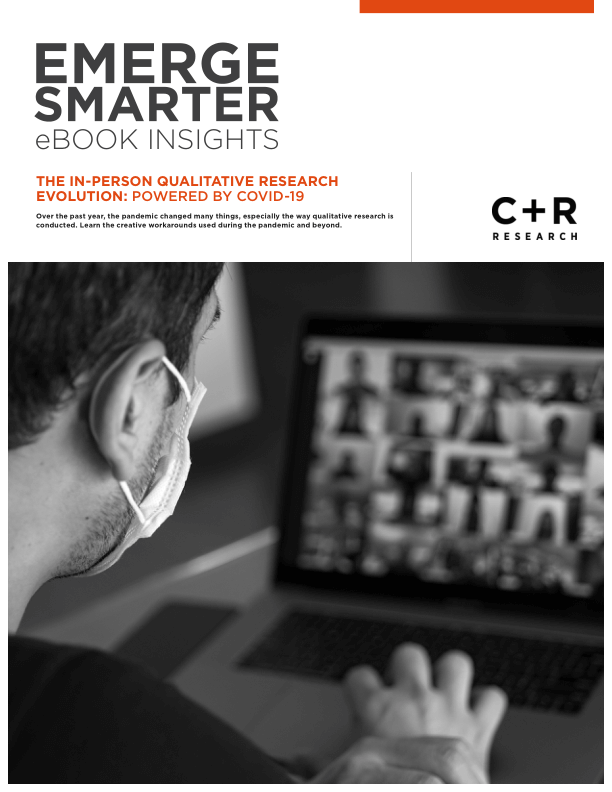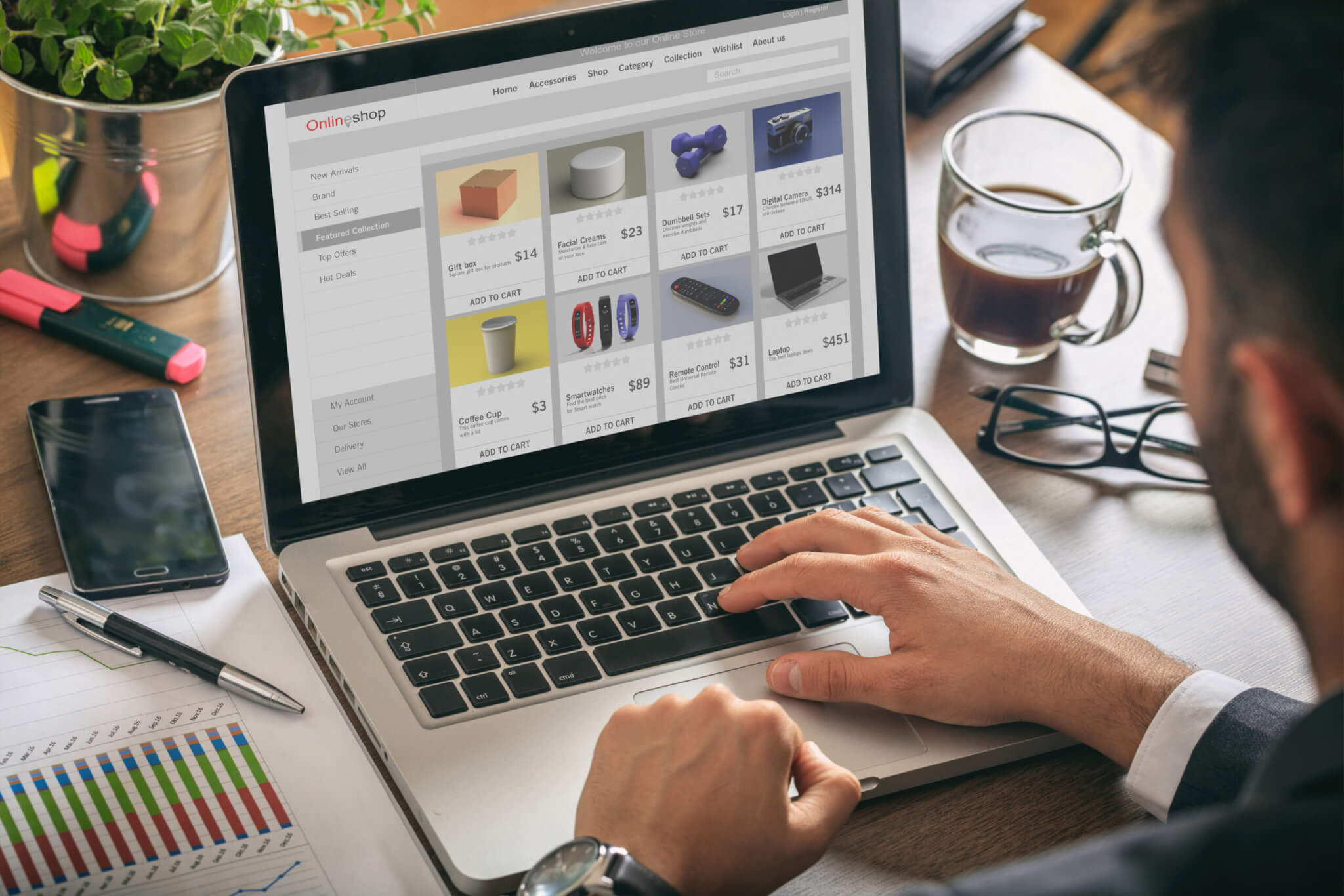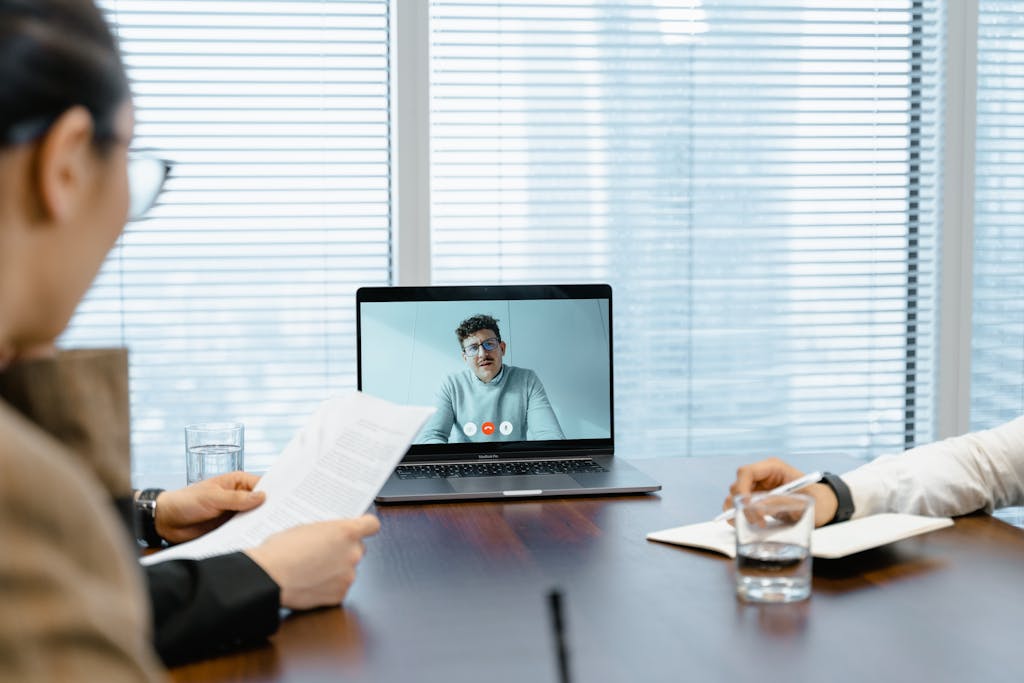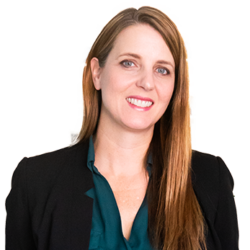
qualitative research evolution: from traditional to live
INTRODUCTION
Over the past year, the Coronavirus pandemic has changed the way market researchers conduct qualitative research. In-person focus groups, in-home interviews, and in-store shop-alongs that are synonymous with “traditional” qualitative research have been put on hold due to safety concerns. However, despite social distancing requirements and travel restrictions, businesses still need to connect personally with consumers to learn about their lives, their needs, and how they use their products and brands. Likewise, there are countless consumers nationwide ready and willing to participate in research from the safety and comfort of their homes.
The pandemic has necessitated that “traditional” or “in-person” qualitative researchers become more agile and creative with how they help businesses reach their consumers. At C+R, this has meant reframing our “in-person” qualitative team to our “live” qualitative team and capitalizing more on digital technologies such as webcams and collaborative whiteboard tools.
While online qual and digital tools are not new to us at C+R, the pandemic required us to deepen our experience with them and develop innovative new ways to transition some traditionally in-person qualitative methodologies into the online space.
contributors to this guide
Erin Barber
President + Chief Client Officer
Kat Figatner
Senior Vice President, In-Person Qualitative Research
the transition from “in-person” to “live” four qualitative methodologies
The transition from “in person” to live/online took place in four main qualitative methodologies:
- Focus groups/In-Depth Interviews (IDIs)
- Shop-alongs
- Ethnographies
- Workshops

ethnographies
Not surprising, ethnographies have also been impacted by the pandemic. For a long time, we’ve taken a hybrid approach to ethnographies – combining insights from digital ethnographies with in-person engagements to observe behaviors in context and gather a deep view into the consumers’ lifestyles and values. In pre-COVID times, these hybrid approaches often involved a split sample – participants from across the US participate online via asynchronous activities whereas in-person ethnographies are centered in select markets. But with COVID, we transitioned this to completely online, engaging with the same participants in both the asynchronous and live components to gain a deeper, holistic understanding of who they are and the role of the category and brands in their lives.
These online hybrid qual projects are primarily conducted in two ways.
- One way is for projects to be anchored in the “asynchronous” component, where the majority of the learnings come from the online board (which can include a variety of activities, projectives, usage journals, missions, etc.), and are augmented with live methods (conversations with superstar respondents over webcam to uncover deeper learnings and bring the findings to life).
- The other way is anchored in the “live” component, where an asynchronous activity is used to generate preliminary contextual information, and the majority of the learnings come from live webcam-based interviews or focus groups.
No matter the approach, a key component for success with these types of hybrid qual methodologies is to avoid overwhelming clients and participants with too many different platforms. Ideally, no matter how many qualitative methods you combine, it’s important to try sticking with one platform, or—if you must use multiple —ensure your client is familiar with at least one of the technologies.

An example of a hybrid project anchored in the asynchronous component was for a client in the financial services industry who wanted to learn more about Gen Z, both as a cohort in general and to understand their specific banking and financial needs.
- Because we are experts in the Gen Z cohort, C+R first led a grounding session for the client team, where we shared proprietary research and knowledge about the unique needs of Gen Z.
- Second, we created an immersive mobile hub/ community where, over the course of two weeks, Gen Z participants posted videos, answered questions, and shared their social media posts. To gain deeper insight into some of the learnings, we invited several ‘superstar’ participants to participate in live moderated “house parties” fun interviews where they were able to share their views on life in general and financial/banking needs and concerns specifically.
A hybrid qualitative project anchored in ‘live’ online qual was a recent project we partnered on with a beverage manufacturer. They wanted to understand the whys behind product usage occasions in order to develop marketing and communication materials to differentiate themselves from their competitors. The primary way we collected insights from consumers was via live moderated one-on- one webcam interviews. However, to glean contextual information into our respondents’ usage and motivation of the category, we asked participants to complete consumption journals online for one week prior to their interviews. The journal entries were captured on the same platform as their interview, meaning respondents (and our client) only had to log in and interact in a single platform
Remote Shop-alongs
Another in-person qualitative research method that has been changed by the pandemic is shop-alongs, where (traditionally) a moderator and client team join a participant in-store to see first-hand how the consumer shops and to dig deeper in real time into the whys behind their shopping behavior. This is a method that is so important to all shopper insights professionals and was one of the first methodologies impacted at C+R by the Coronavirus. At the beginning of the pandemic, we had just begun a traditional in-person shop-along study when, suddenly, social distancing mandates limited the number of people in stores – requiring us to quickly pivot to remote shop-alongs.
During a remote shop-along, the moderator and client ‘tag along’ with a shopper via the respondent’s smartphone, and the store’s WIFI. The smartphone’s back-facing camera allows the moderator and client to get the shopper’s perspective as while shopping in store. The moderator can ask questions in real time to delve into the whys of the consumer’s shopping habits. As with online focus groups, remote shop-alongs enable clients to draw upon a national sample of consumers, as the moderator can remain in a single physical location. The client observers can get their burning questions answered in the moment by sharing them with the moderator in the virtual backroom chat, allowing the moderator to integrate them easily into the conversation.
Recently, a consumer durables manufacturer wanted consumer feedback on a special in-store display set up at a chain of national home improvement stores. Remote one- on-one shop-alongs allowed us to send consumers into the specific stores to view the display and provide feedback.

Online Focus Groups/IDIs
In many ways, moving our IDIs and focus groups online was the easiest transition. We have been doing webcam- based IDIs for years so we didn’t have to think twice about using this methodology. However, moving focus groups online presented some unique challenges – as well as opportunities.
- One interesting challenge has been that even with webcams, non-verbal communication is limited. For example, the subtle eye movements and body positioning participants use in a facility to indicate who will speak next is absent in an online environment. This has led to countless instances of participants speaking over one another – or not speaking at all. One way a moderator can assist with this is to address the limitation up front. To ensure all voices are heard, the moderator can be more proactive by calling on respondents for responses versus a more open conversation typically found in in person focus groups.
- Another way we have addressed this limitation – as well as the time that can be eaten up by technology glitches – is to reduce the number of focus group participants. The number of participants went from six to seven in a traditional group to approximately four to five online. This allows more time for each participant to speak despite any lags that may occur.
The move of this methodology to online has also brought unique opportunities. Tools within the research platform allow respondents to individually rate and provide feedback on stimuli. Their responses are visible in real time to the moderator and client observers, helping to guide the conversation and probes. In addition, as the client team and moderator communicate via the online “backroom chat,” the moderator can seamlessly incorporate the clients’ questions into the conversation – without the disruptive knock on the door with a note to the moderator in a traditional setting.
As mentioned earlier, many people are stuck at home and are eagerly looking for something to do; so there is no shortage of willing respondents for market research studies. Show rates have been as good—or better—than in-person groups where traffic and other logistical complications can prevent people from showing up to the facility on time. Likewise, without the need for a physical meeting space, clients have been able to broaden the geographic location of respondents for studies, allowing them more national representation in a study with no added costs. And, without travel between markets, fieldwork is able to be executed faster than when we’re in-person.

Virtual Workshops
One of our core competencies at C+R is leading in person workshops such as strategy sessions, activation sessions, consumer immersions, and ideation innovation sessions. The in-person version generally entails a group of clients, the C+R team and perhaps a few creative thinking Idea BuildersTM (consumers recruited for their creativity and trained in innovation). We meet at a fun offsite location for a day (or two) to dig into research insights and develop strategic business opportunities or new products, communications, or merchandising ideas based off those insights.
With clients still working from home, we pivoted to virtual workshops. These online work sessions follow the same principles as their in-person counterparts, such as having different periods of the session dedicated to divergence and convergence incorporating play and fun to inspire creativity, and connecting the workshop to the research to build consumer empathy. We’ve found that the strength and number of ideas generated are generally comparable to in-person.
However, we’ve made some changes for this virtual approach. Instead of an offsite location, we use a virtual meeting space, many of which have “breakout room” functionality built in to allow for splitting a larger group into smaller teams to encourage active participation and parallel production. Online whiteboard tools enable the facilitation of fun activities to spur creative thinking and idea generation. But what about the cognitive load involved in having to learn a potentially new program on the fly? Our solution to this is to have what we call ‘drivers’ to handle all the technology with the breakout rooms so our clients solely focus on coming up with new ideas for their brand and not have to worry about learning a new platform.

Another alteration we’ve made for online workshops is that we split up sessions into a few hours per day (rather than running them for a full day), over the course of several days. Zoom Fatigue is real and must be accounted for. Breaking sessions across multiple days keeps participants engaged and able to think of new and creative ideas. And it’s easier to get clients to commit to a couple hours at a time versus giving up an entire workday. Additionally, a series of mini sessions allows for time to debrief, incubate, and iterate our process over the course of the project. Online workshops even offer some unique advantages over traditional workshops, including:
- A wider range of cross-functional teams can participate since budgets and productivity are not dictated by travel. Greater involvement from R&D, Sales, and outside agencies helps generate diverse ideas and gives everyone a chance to be involved. This often yields greater buy-in of the ideas.
- Client teams like it! Virtual ideation can create a greater comfort level among participants.
One of the first online ideations we facilitated was a virtual ideation for a casual dining chain client who urgently needed creative and fun ideas across four core business platforms to win new customers and retain existing ones. They tried to ideate internally, but the ideas fell flat. So, we created an online ideation session that included pre-session homework to spur participant thinking, an ideation session with smaller breakout periods to allow teams to generate across the four platforms, and time at the end to prioritize top ideas. To combat “Zoom fatigue,” the entire ideation session lasted just 2.5 hours; however, the client team still generated over 70 new ideas.
As more business leaders experience them, virtual workshops are likely to become a widespread agile tool for maintaining and even accelerating the pace of innovation. Some marketing and innovation teams say they prefer the virtual approach and plan to continue using it even after travel restrictions are lifted because of the ease of execution and increased engagement.

Conclusion
Over the past year, we’ve learned a lot from expanding our traditional qual business into the online space. We’ve relied on tried-and-true technologies and experimented with new offerings to ensure we continue to help clients answer important business questions generally best answered with “traditional” qualitative methodologies. While we feel there will continue to be a need for in-person qual research, given the cost savings, greater ability to have a national sample, and comparable stats like show rates and number of ideas generated, we hypothesize that these digital approaches will remain important tools in the traditional qualitative toolbox. We’re excited to see what else we can do as the technology continues to evolve – even as we hope to get back into the field full-time as soon as possible!
Erin Barber
President + Chief Client Officer
Kat Figatner
Senior Vice President, In-Person Qualitative Research


